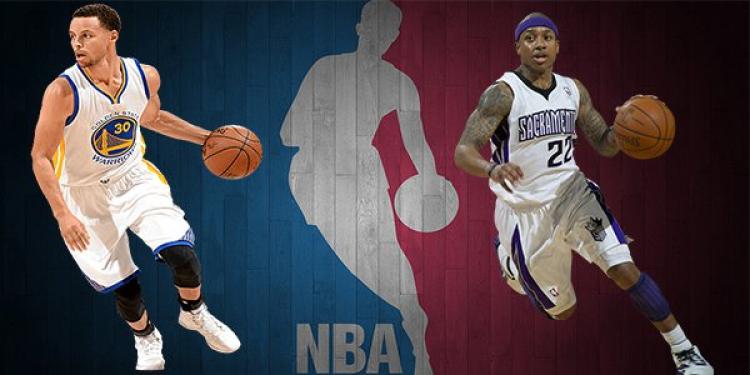The Greatest Point Guards of All Time (part 2)
Posted: May 27, 2015
Updated: October 6, 2017

A look at the greatest to carry the ball up the court
In U.S gambling news, Stephen Curry, National Basketball Association’s Most Valuable Player (MVP) for the 2014/2015 season, is currently leading the Golden State Warriors past the Houston Rockets. His quickness and shooting ability from anywhere in the court are qualities that define a point guard. Plus a good eye is needed to look for players that are open and getting the ball to them so they can make shots.
• John Stockton is the NBA all-time assist leader with 15,806 assists
• Bob Cousy’s fancy ball handling and no look passes led to 20 points a game
• Magic Johnson can successfully play every position at a professional level
The point guards can control the tempo of a game. By simply holding the ball while slowing the dribble, the whole game will slow down. When the point guard runs the ball up the court, the whole game will speed up. Both abilities are useful tools if the opposite team is “hot” and there’s a need to cool them down or if your team is hot there’s a need to keep the heat going. These point guards definitely know how to move the themostat.
Gonzaga University’s Stockton and Cousy the original showman
John Stockton, at first glance may appear more the “boy next door” rather than one of the most fearless point guards ever. With 15,806 assists, Stockton is the all-time assist leader in the NBA. Rarely making mistakes, Stockton always made the right decisions without having to take a lot of steps to do it. His efficiency is unmatched and caused Stockton to be major speedster suitable for faster paced west coast basketball.
Not considered athletic, Stockton scratched, grabbed, clawed, swiped at the ball in order to possess it and get himself into position. With Utah Jazz partner Karl “The Mailman” Malone, the two put on a show of pick and rolls, reverse dunks, lay ups and mid-range jumpers. Being an incredible shooter, Stockton would use this skill sparingly every now and then preparing to pass to Malone, then stepping back to drain the three-point shot.
Bob Cousy often found himself without a team. Similar to the last kid waiting to be picked by either team, Cousy denied the Tri Cities Blackhawks and barged his way into the Boston Celtics, only after his Chicago Stags went bust. He was treated more like an “experiment” than a legitimate addition. General Manager Red Auerback had doubts Cousy’s showmanship would work in the professional league and gambled on Cousy in a way as critical as if it were outside U.S gambling laws.
It wasn’t long before the “Houdini of the Hardwood” worked his magic on fans with fancy ball handling, no look passes and a very real contribution of 20 points per game. Soon Cousy became NBA leader in assists for eight straight seasons. From 1957 to 1963, Cousy joined forces with Bill Russell, one of the greatest ball players ever, to bring six NBA championships to Boston.
From Isiah Thomas to Earvin “Magic” Johnson
Isiah Thomas, from Chicago, was on the basketball team at Marquette, a well-known preparatory high school where he learned fundamental basketball. Playing for Indiana University under the wing of the legendary coach Bobby Knight, Thomas’ fundamental play helped him succeed. As the point guard for the Detroit Knicks, Thomas had to lead a team called the “Bad boys” for their rough “do whatever it takes” style of play.
Early in his career, Thomas averaged 26 points a game and was able to take the “Bad boy” into the playoffs several times. Unfortunately, their best years were in the middle of three dynasties, the LA, Boston and Chicago. Each of the three put their damage on Detroit with the Chicago Bull instilling the greatest effect. The Pistons were able to get two championships in 1989 and 1990.

Oscar Robertson played on Cincinnati Royals and Milwaukee Bucks for 14 season. In his first years Robertson averaged 30 points, 10 rebounds and 11 assists a game. Once leading a season in points, assists, free throw attempts, free throw percentages and minutes played, Robertson certainly was versatile, if not completely generous with the ball.
Robertson amassed 181 triple doubles in which points, rebounds and assists were in double digits. After joining Milwaukee in 1970, Robertson benefitted from being on a strong team with Lew Alcindor (Kareem Abdul Jabbar) where they won the championship over Baltimore that year. A run which would have made punters using online sportsbooks in the U.S win some serious money.

In some ways, it’s unfair to put Erving “Magic Johnson” on this list. Although he has always been technically registers as a point guard, Johnson can successfully play every position at a professional level. A 6 foot 9 inches, Johnson epitomized athleticism and intelligence. Coming from Michigan, he played for Michigan State University and won the NCAA championship of Larry Bird and his Indiana State team. A rivalry between Magic and Bird would last throughout their professional careers.
As a LA Laker, Magic helped to defeat Julius “Dr. J” Erving and his Philadelphia 76ers in his first of five championship titles for the Lakers. Magic brought a splendor making the team synonymous with its “showtime” image. Through major marketing, Magic’s Lakers and Bird’s Boston Celtics brought the NBA to the most popular periods in its corporate history. Winning two out of the three confrontations, Magic’s team would prove dominate until they were overtaking by Michael Jordan and his Chicago Bulls.












